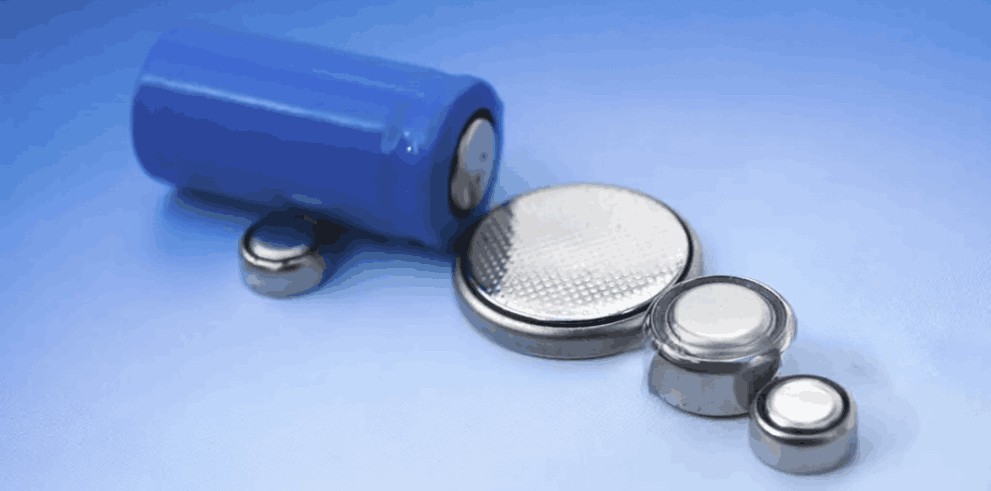Although both lithium manganese dioxide (Li-MnO₂) and lithium-ion (Li-ion) batteries belong to the lithium battery family, they differ significantly in terms of chemical structure, performance characteristics, and application scenarios. This article offers a comparative analysis from the perspectives of technical principles, key parameters, and practical use cases to provide a professional reference for equipment selection.
Electrode Materials
Cathode: Manganese dioxide (MnO₂), with a layered structure enabling lithium-ion intercalation for charge transfer.
Anode: Metallic lithium (Li), with a theoretical specific capacity of 3860 mAh/g, serving as the primary energy source.
Electrolyte: Organic lithium salts (e.g., LiClO₄) dissolved in carbonate solvents, enabling ion conduction but irreversible reactions.
Operating Characteristics
Supports only one-time discharge, based on the reaction: Li+MnO2→LiMnO2
Once energy is released, recharging is not possible.
Internal resistance increases during discharge, with voltage dropping sharply at the end — ideal for low-power, one-time-use applications.

Electrode Materials
Graphite: Theoretical capacity of 372 mAh/g, enabling reversible lithium-ion intercalation with >95% efficiency.
Silicon-based anodes (emerging): Theoretical capacity of 4200 mAh/g, though expansion (>300%) remains a technical challenge.
LiCoO₂ (Lithium Cobalt Oxide): High energy density (274 mAh/g), widely used in smartphones and consumer electronics.
LiFePO₄ (LFP): Excellent thermal stability (>500℃) and long cycle life (>3000 cycles), dominant in power battery applications.
LiMn₂O₄ (LMO): Cost-effective and heat-resistant, suitable for power tools.
Cathode Options
Electrolyte: Lithium hexafluorophosphate (LiPF₆) dissolved in a solvent blend (EC + DMC + EMC), supporting reversible lithium-ion transport.
Operating Characteristics: Supports rechargeable cycles, with a battery management system (BMS) providing overcharge, overdischarge, and overcurrent protection.
| Parameter | Li-MnO₂ Battery (e.g., CR2032) | Li-ion Battery (Industry Avg.) | Difference Explained |
|---|---|---|---|
| Nominal Voltage | 3.0V | 3.2V (LFP) / 3.7V (NMC) | Li-ion offers higher voltage platforms suitable for high-power devices |
| Energy Density | 550 Wh/L | 600–900 Wh/L | Li-ion provides 30%–60% more endurance |
| Cycle Life | 1 (non-rechargeable) | 300–3000 cycles (material dependent) | Li-ion fits high-frequency, long-term use |
| Operating Temp. | -40℃ to 60℃ | -30℃ to 60℃ (some versions up to -40℃ to 85℃) | Li-ion shows better high-temp adaptability |
| Self-Discharge | <1% per year | <3% per month | Li-MnO₂ better for long-term standby |
| Safety Design | No protection circuit | Built-in BMS | Li-ion requires electronic protection |
Li-MnO₂: Lower manufacturing cost as a single-use battery, ideal for low-power devices.
Li-ion: Higher upfront cost, but lower total cost over time due to rechargeability — best for high-energy-demand applications.
Li-MnO₂ Lifespan Limitations
Limited by non-rechargeable design — lifespan depends solely on discharge duration.
Example: CR123A used in smart water meters can last up to 10 years but not suited for high-frequency applications.
Typical uses: Remote controls (1–2 replacements/year), emergency lights (1 replacement every 5 years).
Li-ion Longevity
LFP batteries: >3000 cycles — 8+ years of use with daily cycling.
LiPo batteries: ≥500 cycles — suitable for 2–3-year product lifecycles in wearables.
Typical uses: Consumer electronics (500 cycles ≈ 2 years), LFP for energy storage systems (2000 cycles, 10 years maintenance-free).
Common Applications
Industrial meters: Built-in power for smart water/gas meters; CR123A (3V/1500mAh) offers >10 years of power.
Security devices: Smoke detectors, emergency beacons — leverage ultra-low self-discharge (<0.3%/month).
Selection Notes
Ideal for "single-use, low power, long shelf life" use cases like remotes, digital scales.
Common Applications
Consumer electronics: Smartphones (LiCoO₂), smartwatches (LiPo) — support fast charging and long cycle life.
Power batteries: EVs (LFP) — >500 km range, >2000 cycles.
Industrial equipment: AGV robots (38.4V/100Ah LFP) — 24/7 operation, -30℃ cold start.
Energy storage: Residential storage (10kWh LFP) — 95% charge/discharge efficiency for solar integration.
Selection Notes
Best for "frequent cycling, high energy, long life" scenarios like 3C electronics, EVs, smart hardware.
Li-MnO₂: Material Upgrades to Extend Capabilities
Composite cathode technology: MnO₂ + CNT improves conductivity, raising discharge platform from 2.8V to 3.0V.
Extreme environment adaptations: Military-grade glass-encapsulated cells work from -55℃ to 85℃ for aerospace needs.
Li-ion: Performance Breakthroughs and Ecosystem Innovation
Solid-state batteries: Sulfide electrolytes push energy density >500 Wh/kg, with mass production expected by 2030 — solves leakage and dendrite issues.
Recycling systems: EU's new Battery Directive targets a 90% recycling rate by 2030, with second-life applications as a key industry focus.
As an active player in China's lithium battery sector, Yilai focuses on large-scale lithium-ion battery applications, providing full-process solutions from cell selection to system integration:
Standard Products
18650 NMC Cell (3.7V / 2500mAh): Tailored for smart hardware, ≥500 cycle life, certified by UN38.3 and MSDS.
LFP Energy Storage Cell (3.2V / 100Ah): Supports -30℃ cold start, ideal for distributed energy storage.
Customized Development
Designed ultra-thin LiPo batteries for medical devices with IP68 waterproofing.
Developed 25C high-rate cells for industrial drones, supporting 1-hour fast charging.
Li-MnO₂ and Li-ion batteries have formed distinct technical ecosystems for static energy storage and dynamic power supply, respectively. Enterprises should evaluate energy needs, usage frequency, environmental conditions, and lifecycle cost to make informed decisions. Yilai leverages its technical expertise to deliver high-performance, cost-effective lithium battery solutions that drive energy efficiency across industries.